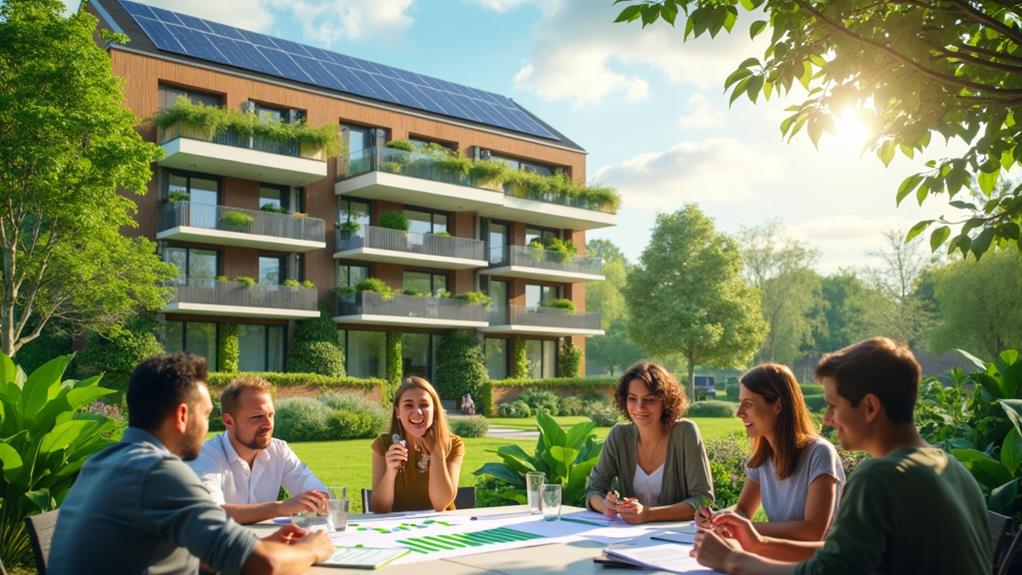Creating a sustainable strata budget involves meticulous planning and strategic investments. Begin with energy audits to uncover inefficiencies and adopt energy-efficient systems such as LED lighting, complemented by renewable energy sources like solar panels. Implement water conservation strategies, including low-flow fixtures and native landscaping, to markedly reduce water use. Establish robust waste management practices by setting up accessible recycling and composting programs. Engage the community through workshops and feedback mechanisms to foster a collaborative approach towards sustainability. Leverage government incentives to ease costs and adopt a vigilant financial monitoring system, continuously evaluating expenditures and planning for future upgrades. Learn more on achieving a thorough sustainable solution. Collaborating closely with experienced strata managers can ensure a streamlined approach to implementing these sustainable practices, as they bring valuable expertise in navigating compliance, budgeting, and community engagement.
Assess Current Energy Usage
Evaluating current energy usage is a pivotal step in developing a sustainable strata budget. Up to 60% of energy consumption in apartment buildings is linked to common property areas, necessitating the identification of high-use zones for targeted efficiency improvements.
To achieve this, conducting energy audits is vital as they uncover areas of excessive consumption and potential savings. Remarkably, simple measures identified through audits can lead to over 40% reduction in energy use.
Benchmarking through programs such as NABERS offers a clear understanding of energy efficiency performance compared to similar buildings, thereby guiding necessary enhancements. This comparative analysis is instrumental for strata schemes aiming for improved sustainability and cost-effectiveness.
Regularly monitoring energy usage is another critical component, as it helps in tracking usage trends, identifying anomalies, and allowing for proactive management. This ongoing vigilance guarantees any deviations are promptly addressed, thereby optimizing energy expenditure.
Moreover, upgrading to energy-efficient lighting and systems, such as LED bulbs and variable speed drives, can make a substantial impact. These upgrades not only lower energy consumption but also enhance overall building performance, contributing to a safer, more sustainable living environment.
Implement Water Conservation Measures
Addressing energy usage is just one aspect of creating a sustainable strata budget; attention must also be given to water conservation measures.
Implementing low flow fixtures in showers and faucets can cut water consumption by up to 50% compared to standard models, offering an immediate reduction in water usage and costs. Participation in programs like Sydney Water’s WaterFix can lead to thorough plumbing audits, identifying leaks and inefficiencies that can save strata communities up to $65,000 annually through targeted upgrades.
Optimizing irrigation systems by replacing existing setups with timed watering systems guarantees that communal gardens receive water only when necessary, preventing wastage.
Utilizing native landscaping in common areas further supports water conservation, as these plants are naturally adapted to the local climate and require less water and maintenance.
Additionally, implementing separate water meters for each lot fosters accountability among residents, encouraging mindful water usage and facilitating the identification of excessive consumption.
These measures not only contribute to a sustainable strata budget but also promote a culture of conservation and responsibility, guaranteeing long-term benefits for both the environment and the community.
Adopt Renewable Energy Solutions
Adopting renewable energy solutions is a pivotal step for strata communities seeking to achieve both financial savings and environmental sustainability. Investing in renewable energy technologies, such as solar panel installations, can notably reduce energy consumption in strata buildings, with potential savings of over 40% in energy use.
The solar panel benefits extend beyond mere cost reduction, providing a reliable and eco-friendly source of energy that aligns with modern sustainability goals.
The NSW Government’s Energy Savings Scheme offers financial incentives that can offset the initial installation costs, making the shift to renewable energy more accessible.
Additional energy efficiency improvements can be achieved with solar hot water systems and heat pump systems, reducing reliance on traditional electricity sources for heating water. This not only enhances energy efficiency but also promotes safety by minimizing the risk of electrical malfunctions.
Moreover, incorporating variable speed drives (VSD) in common property motor and pump systems can further optimize energy efficiency and lower operational costs.
Conducting energy audits is essential to identify the most effective renewable energy options for your strata, ensuring targeted and beneficial investments.
Optimize Waste Management Practices
Optimizing waste management practices within strata communities is vital for fostering environmental sustainability and enhancing communal living standards. Implementing accessible recycling bins throughout the strata encourages residents to recycle properly, thus reducing landfill waste and promoting efficient waste management.
To complement these efforts, introducing composting initiatives for organic waste disposal can considerably decrease the volume of waste sent to landfills. This not only promotes a circular economy but also enriches the community’s commitment to sustainability.
E-waste recycling programs are another important component. Organizing these programs facilitates the responsible disposal of electronic devices, thus minimizing hazardous waste. Clear signage and educational materials should be utilized to inform residents about proper recycling practices. Studies indicate that effective recycling education can increase recycling rates by up to 30%, making it a vital element in optimizing waste management.
Additionally, establishing partnerships with local organizations for battery and mobile phone recycling initiatives guarantees that hazardous materials are disposed of correctly. This not only promotes safety but also fosters community involvement in sustainability efforts.
Through these meticulously planned measures, strata communities can achieve a higher standard of waste management, consequently enhancing both environmental and community well-being.
Enhance Community Engagement
Fostering a culture of sustainability within strata communities requires deliberate and consistent efforts to enhance community engagement. Establishing resident committees dedicated to sustainability initiatives can be instrumental in encouraging active participation and collaboration. These committees can spearhead various projects, ensuring that sustainability becomes an integral part of the community’s ethos.
Hosting regular community workshops and information sessions is another effective strategy. These events can educate residents on energy-saving measures and other sustainable practices, fostering a shared sense of responsibility. Additionally, implementing a feedback mechanism allows residents to suggest sustainability projects or improvements, ensuring their voices are heard and increasing buy-in for community initiatives.
Organizing community events, such as clean-up days or planting sessions, can also strengthen community ties while promoting environmentally friendly practices. These activities not only enhance the physical environment but also build a sense of camaraderie among residents.
Collaboration with local organizations and programs can further enhance community engagement. By leveraging external resources and expertise, strata communities can broaden the impact of their sustainability projects. These partnerships can provide valuable insights and support, making it easier to implement effective and impactful initiatives.
Leverage Government Incentives
Building on the momentum of community engagement, strata communities can greatly benefit from leveraging available government incentives to enhance their sustainability efforts. Programs like the NSW Government’s Energy Savings Scheme notably reduce upfront costs for energy-efficient upgrades, making it financially feasible for strata properties to implement such improvements.
Owners corporations can streamline the approval process for sustainability projects under recent amendments to the Strata Schemes Management Act, requiring only a simple majority vote.
Financial incentives are often available for strata schemes that participate in energy audits, which can identify potential savings and efficiency improvements. These audits not only provide a roadmap for enhancing energy efficiency but also make funding applications more robust by detailing expected cost savings and environmental benefits.
Additionally, local councils frequently offer rebates for water-saving devices, such as low-flow taps and showerheads, thereby supporting water conservation efforts within strata communities.
Engaging with these government programs can lead to substantial savings. For instance, the CommunityUtilities program has reported average savings of $3,628 per scheme through competitive energy rates.
Monitor Financial Performance
Effective financial management is fundamental for the success of sustainability initiatives within strata communities. Regularly evaluating the strata budget against actual expenditures is critical to identify variances and make necessary budget adjustments. This process guarantees that financial performance consistently aligns with the community’s sustainability goals.
Implementing a robust financial monitoring system is essential. This system should include timely reminders for levy payments, which enhance cash flow management and support ongoing sustainability projects. Additionally, continuous reviews of levies confirm they meet the property’s maintenance needs and facilitate sustainable investments without causing undue financial strain on residents.
Energy audits play a significant role in this monitoring process by pinpointing areas of excessive consumption. These insights allow for targeted financial planning and resource allocation towards energy-efficient upgrades.
Tracking the financial impact of such sustainability initiatives, including energy and water savings, helps demonstrate cost reductions and reinforces the value of sustainable practices to residents.
Plan for Future Upgrades
Planning for future upgrades is a strategic necessity for strata communities aiming to enhance sustainability. To effectively manage this, assess current infrastructure and prioritize upgrades based on energy and water efficiency benchmarks. Target a reduction of over 40% in energy use through simple measures, setting clear sustainability priorities.
Allocate a portion of the strata budget specifically for sustainability projects. This enables the implementation of energy-efficient technologies such as LED lighting and solar installations, which can markedly reduce operational costs over time.
Including future capital expenditure in the budget is essential to address critical upgrades, such as integrating smart technology for real-time monitoring of energy and water consumption. This proactive approach not only enhances efficiency but also guarantees safety and reliability.
Incorporating government incentives and rebates for sustainable upgrades can greatly offset initial investment costs, improving long-term financial sustainability. Engaging residents in the budgeting process is equally important. Gathering input on sustainability priorities fosters community support and guarantees that future upgrades align with collective goals.
Conclusion
Creating a sustainable strata budget is akin to weaving a resilient tapestry, where each thread—ranging from energy assessment and water conservation to waste management and community engagement—plays an integral role. By leveraging government incentives and monitoring financial performance, a robust foundation is laid for future upgrades. Such meticulous planning not only fortifies fiscal health but also fosters an environmentally conscious community, ensuring that the strata thrives in harmony with both economic and ecological imperatives.




